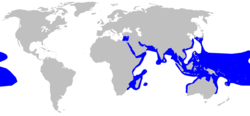Blacktip reef shark
2007 Schools Wikipedia Selection. Related subjects: Insects, Reptiles and Fish
- Not to be confused with blacktip shark.
| iBlacktip reef shark | ||||||||||||||||
|---|---|---|---|---|---|---|---|---|---|---|---|---|---|---|---|---|
 |
||||||||||||||||
|
|
||||||||||||||||
| Scientific classification | ||||||||||||||||
|
||||||||||||||||
|
|
||||||||||||||||
| Carcharhinus melanopterus ( Quoy & Gaimard, 1824) |
||||||||||||||||
 Range of blacktip reef shark
|
The blacktip reef shark, Carcharhinus melanopterus, is a shark of tropical and warm temperate seas. It is often confused with the blacktip shark, Carcharhinus limbatus.
Distribution
One of the most common sharks found in shallow (sometimes as shallow as 30 cm) water around coral reefs of Indo-Pacific and Caribbean waters. The water they swim in is usually 20–27° C (70–80º F). Blacktip reef sharks do not venture into tropical lakes and rivers far from the ocean.
Appearance
As its name suggests, the tips of the shark's pectoral fins and dorsal fin are black, with a white underside. Their skin is brownish in colour on the top-half of their bodies. It has been recorded at up to 190 cm (6 ft) in length. Its snout is blunt and rounded. The gray reef shark looks similar, and is also common, but is distinguished by its stockier and gray body and its lack of black tip on the dorsal fin. Blacktip reef sharks are not considered a real threat because they are usually small.
Diet
A blacktip reef shark's diet consists mainly of reef fish, but they will also feed on sturgeon and mullet.
Reproduction, behaviour, and interaction with humans
Reproduction is viviparous, with 2 to 4 pups in a litter. Before giving birth, female blacktip reef sharks will incubate their young for 16 months. The shark's size at birth ranges from 33–52 cm.
This species is not considered social, but can been seen in small groups. While generally shy, they often are curious about snorkelers and scuba divers. As with most sharks, the body is bent into a sort of "S" shape when the shark feels threatened. Blacktip reef sharks are harmless unless provoked. Incidents generally involve hand feeding or spear fishing, possibly in combination with low visibility.
The blacktip is one of only a few sharks that can jump fully out of the water, a behaviour called breaching. They have also been observed surfacing to look around (spy-hopping).
Population decline
Blacktip reef sharks are often the bycatch from other fisheries and are often wasted. The blacktip populations are declining, and so are the population of many other shark species. Their fins are used for shark fin soup - when caught the shark's fin is cut off and the shark is thrown back into the water to die. This is done by the thousands, which may be a big factor in why the population is declining. The numbers of blacktip reef sharks have declined in recent years.


